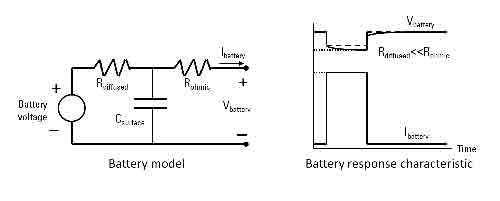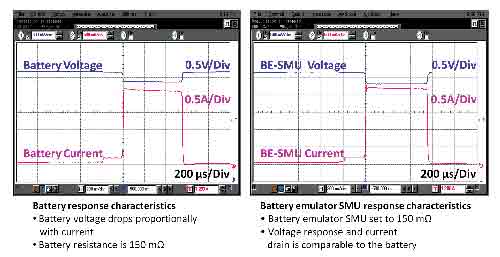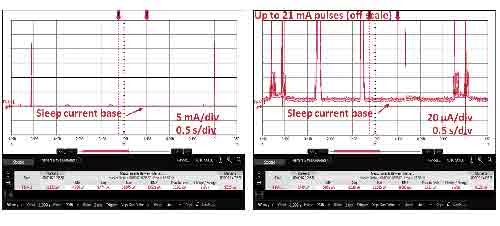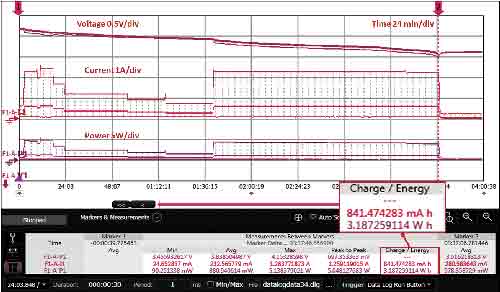Latest News
March 1, 2012
By Edward Brorein
There is a worldwide revolution taking place: All kinds of things in our daily lives are becoming wireless—not only our mobile phones and the Wi-Fi for our laptops, but our home’s climate monitoring and controls, our utility meters, our medical health monitors, and even sensors in the bridges we drive over are examples of this.
Most of these devices are battery-powered. Some devices, like mobile phones, are rechargeable—and they usually make it through a day before needing a recharge. Other devices, however, like a wireless outdoor thermometer, can run for a year or longer on its disposable battery.

Figure 1: Real-time battery model and load response characteristics.
Whether the device runs for a day, a month or a year, one thing that has not kept up with the rapid rate of wireless innovation is the battery. There is a clear need to optimize all these devices to get the maximum possible run time from their batteries.
A precision source measure unit, or SMU, would seem like an ideal instrument for powering a variety of battery-powered devices and accurately measuring their respective battery drains. However, in practice this turns out not to be the case. The critical difference is the use-model for which traditional SMUs are tailored: powering and characterizing functionally passive devices. In contrast, when you optimize battery run time, you are powering and characterizing a functionally active device. This is a very different use-model calling for a different kind of SMU, one having real-time sourcing, measurement and operational capabilities to address this need.
Real-time Battery Emulation
A battery is a non-ideal energy source. Its output voltage varies with loading, temperature, charge, time and even its history. The basic real-time behavior of a battery is usually modeled as a variable voltage source with series impedance. The battery voltage instantaneously drops in proportion to the current drawn as a result.
A little more elaborate, real-time model also includes the resistor “capacitor (RC) stage, simulating the slight voltage droop and recovery effects many batteries exhibit during heavy loading and unloading. This is governed by the charge more immediately available vs. that which exists deeper in the battery’s structure. This battery model and its response characteristics to pulsed loading are shown in Figure 1. Because of a battery’s non-idealities, it interacts with and influences the performance of the device it is powering.

Figure 2: Actual battery and battery emulator SMU voltage response characteristics.
A traditional SMU strives to be as precise of a static direct-current (DC) voltage as possible. Delay time is used to let it settle acceptably close to its set level before a measurement is taken. While this is good for powering functionally passive devices, it is not as well suited for battery-powered devices, thanks to the devices’ dynamic loading and interdependency with their non-ideal batteries.
A traditional SMU often has excessive transient under- and overshoot voltage at load transitions, and lacks the battery’s voltage drop response in proportion to the load current. This alters the performance and current draw of many battery-powered devices. For some devices, a large enough transient drop can even trigger the low battery voltage shutdown.
In comparison, SMUs tailored for battery-powered devices incorporate extremely fast transient voltage response and programmable series output resistance to provide basic, real-time battery emulation. An example of this is shown in the oscilloscope screen captures of a mobile phone’s input power in Figure 2. The SMU output response behavior is similar to the battery, providing more realistic device performance and comparable current drain—and thus more accurate test results.
Volume vs. Range
To conserve energy, most battery-powered devices transmit or otherwise operate in short bursts of activities. They then drop down to an extremely low power idle or sleep state between these periodic activities. The resulting current drain is pulsed. The minimum- and average-to-maximum ratios often span as much as four decades, depending on the device and how deeply it powers down between its bursts of activities.
Because most battery-powered devices spend most, if not all, of their time operating in a power savings mode, it is important you optimize these modes. Real-time, high-speed digitized measurement of the minimum and maximum values, and everything in between, is essential for you to get the detailed insights needed for optimizing the battery run-time.

Figure 3: Pulsed current drain measurement on a wireless temperature transmitter.
A traditional SMU has a multitude of measurement ranges, usually spaced just a decade apart, allowing it to accurately measure from femtoamps to amps. While this is an extremely wide range, it is a static capability. It can only use one range at a time when making a measurement. While this is excellent for characterizing functionally passive devices drawing static currents, it is not as well suited for battery-powered devices drawing pulsed currents. A measurement range has a typical error of 0.03% of reading plus 0.03% of range. The percent of range offset error limits the dynamic range of measurement accuracy. For example, for 0.03% offset error, to achieve up to 3% accuracy for a pulsed signal’s floor level, the signal cannot span more than two decades.
Tadiran Introduces New Batteries The AA-sized TLM 1550 features an open circuit voltage of 4.0 volt, and the ability to handle pulses of up to 15A, with 5A maximum continuous load. According to the company, the TLM offers very long life in extreme environmental conditions, including a self-discharge rate of less than 3% per year at room temperature, and a temperature range of (-40 °C to +85 °C). TLM Military Grade cylindrical batteries feature an open circuit voltage of 4V, with a discharge capacity of 500 mAh (20 mA at 2.8V RT), capable of handling 5A continuous pulses and 15A maximum high current pulses. They feature low self-discharge and an operating temperature range of -40 °C to 85 °C. The batteries comply with various MIL-STD 810G specs and UN 1642 and IEC 60086 standards for ruggedness. |
What is instead needed for battery-powered devices drawing pulsed currents is an extremely wide dynamic range of measurement having low offset error. However, measuring the floor for a signal spanning four decades with 3% accuracy calls for just 0.0003% offset error. This performance is not available in traditional SMUs. You sometimes can adopt workarounds to get past this inherent limitation, but not without suffering significant consequences as a result.
In Figure 3, we measured the pulsed current drain on a wireless temperature transmitter. On the left, you can see it transmits every 4 seconds, drawing a peak current of about 21 mA. On the right, we expanded the amplitude scale to 20 µA/div. Together with measuring the peaks, we were also able to observe and accurately measure the overall average current of 53 µA, as well as the sleep current of just 8.7 µA. We used an Agilent N6781A SMU and related software, tailored for battery-powered devices. The N6781A has conventional 1 mA, 100 mA and 3 A measurement ranges. However, unlike traditional SMUs, the N6781A seamlessly selects its most accurate range in real-time, based on the instantaneous level of the signal, to provide a high-speed, wide dynamic range, continuous measurement in just one pass.
Parametric vs. Time-based Measurement
One key aspect of testing battery-powered devices is measuring and evaluating the current and voltage over short and long time periods, sampled at high rates, to provide the insights for optimizing run time.
Traditional SMUs are tailored for generating I-V parametric curves of functionally passive devices by forcing a series of voltage or current settings, and making the corresponding current or voltage measurements independent of time. The SMU and device, in turn, wait upon the other to be ready at each setting. While some traditional SMUs support higher sampling rates for short time-based measurement acquisitions, they lack all the operational capabilities useful for battery-powered device testing.

Figure 4: Battery run-down test on a GSM mobile phone.
SMUs for testing battery-powered devices need to operate like an oscilloscope, for fast dynamic waveform acquisitions, and similar to a data logger, for long-term acquisitions, capturing and displaying voltage, current and power against time. They should compute area-under-the-curve amp-hour capacity and watt-hour energy values, key for assessing and optimizing run-time of battery-powered devices. They should also have configuration flexibility to allow logging their own voltage and current when directly powering the device, as well as remotely logging the output of an actual battery when performing a run-down test. Figure 4 shows the results of a battery run-down test performed on a mobile phone together with its battery. These capabilities greatly simplify the task of battery drain measurement and analysis.
Final Thoughts
There is indeed a revolution taking place, with all kinds of new wireless devices being innovated. It’s imperative we get the most out of the batteries available. While a traditional SMU would at first seem to be a logical choice for powering and measuring current drain for battery-powered devices, we have learned here that this turns out not to be the wisest choice. Optimizing battery-powered devices is instead better served by using SMUs having real-time sourcing, measurement, and operational capabilities tailored specifically for this task.
Edward Brorein is an engineer at Agilent Technologies. Contact him via [email protected].
MORE INFO
Subscribe to our FREE magazine, FREE email newsletters or both!
Latest News
About the Author
DE’s editors contribute news and new product announcements to Digital Engineering.
Press releases may be sent to them via [email protected].





